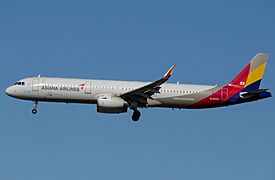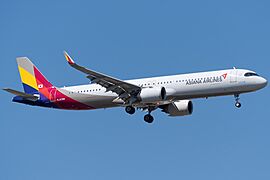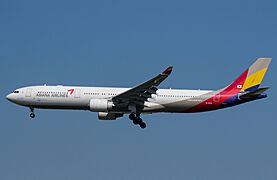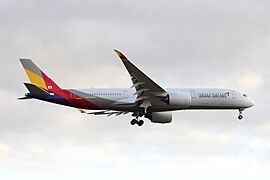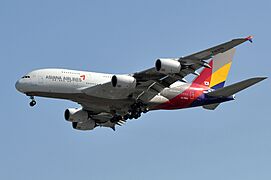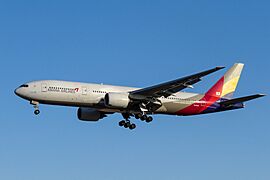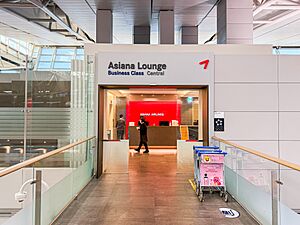Asiana Airlines facts for kids
| Founded | 17 February 1988 (as Seoul Airlines) |
|---|---|
| Commenced operations | 23 December 1988 |
| Hubs |
|
| Focus cities | Jeju |
| Frequent-flyer program | Asiana Club |
| Alliance | Star Alliance |
| Subsidiaries |
|
| Fleet size | 81 |
| Destinations | 78 |
| Parent company |
|
| Headquarters | Osoe-dong, Gangseo District, Seoul, South Korea |
| Key people | Won Yoo-seok (president & CEO) |
| Revenue | |
| Employees | 10,380 (2015) |
| Asiana Airlines | |
| Hangul |
아시아나항공
|
|---|---|
| Hanja |
아시아나航空
|
| Revised Romanization | Asiana Hanggong |
| McCune–Reischauer | Asiana Hanggong |
Asiana Airlines Inc. is a major airline from South Korea. Its main office is in Seoul. The airline flies to many places around the world. It has about 90 international routes and 14 routes within South Korea. It also carries cargo on 27 routes.
In 2019, Asiana Airlines handled a quarter of all international flights in South Korea. It also managed 20% of flights within the country. Its main international airport is Incheon International Airport. For domestic flights, its main airport is Gimpo International Airport, both in Seoul.
Asiana Airlines is part of a group called Star Alliance. This is a big network of airlines that work together. Asiana also has two smaller airlines that offer cheaper flights: Air Busan and Air Seoul. Asiana Airlines owns a large part of Air Busan. Air Seoul is fully owned by Asiana.
Contents
History of Asiana Airlines
How Asiana Started
Before Asiana, Korean Air was the only big airline in South Korea. It was owned by a company called Hanjin Transportation since 1969. Other large Korean companies, known as chaebols, wanted to compete. So, Asiana Airlines was created.
The Kumho Asiana Group started Asiana Airlines. It was first called Seoul Air International. Asiana began on February 17, 1988. Its first flights started in December 1988, going to Busan.
First Flights and Growth
Asiana began flying in December 1988. It used Boeing 737 Classic planes. Its first destinations were Busan and Gwangju. In 1989, Asiana added regular flights to Jeju City, Gwangju, and Daegu. Later that year, it started international charter flights to Sendai, Japan.
In 1990, Asiana began its first regular international flights. These went to Japanese cities like Tokyo, Nagoya, Sendai, and Fukuoka. By early 1991, Asiana flew to Bangkok, Singapore, Hong Kong, and Taipei. Flights across the Pacific Ocean to Los Angeles started in December 1991. Asiana used a Boeing 747-400 Combi for these long flights. By the mid-1990s, flights to Vienna, Brussels, and Honolulu also began. In 1993, Asiana started flying to Ho Chi Minh City in Vietnam.
Becoming a Global Airline
Asiana Airlines grew quickly after it started in 1988. It became a medium-sized global airline. By 2004, its fleet had 85 aircraft. In December 1998, the airline flew the president of South Korea for the first time.
On January 28, 2003, Asiana joined Star Alliance. This helped it connect to more places around the world. In 2004, the airline added Airbus A330 and Boeing 777-200ER planes. It also added more routes to mainland China. Asiana now flies to 71 cities in 23 countries. It also has a cargo division called Asiana Cargo.
New Look for the Airline
In February 2006, Asiana Airlines updated its look. This was to match other parts of its parent company, the Kumho Asiana Group. The names of the travel classes changed. First, business, and economy classes became first, business, and travel classes. The colors for these classes also changed to yellow, blue, and red. New uniforms were also designed for the flight crew.
Financial Challenges
In April 2019, Kumho Asiana Group, the company that owned Asiana Airlines, decided to sell the airline. This was to help with its financial problems. The sale process started in July 2019. Several companies showed interest in buying Asiana.
Asiana Airlines stopped flying on some routes that were not making money. These included flights from Seoul–Incheon to places like Chicago–O'Hare and Delhi.
In July 2020, the plan for HDC Hyundai Development Company to buy Asiana Airlines was canceled. This happened because of problems with the deal. Asiana Airlines was then managed by its lenders until a new owner could be found.
Joining Korean Air
In November 2020, the South Korean government announced a plan. It wanted to merge Asiana Airlines with Korean Air. Korean Air would buy a large part of Asiana Airlines. The two airlines were planned to operate separately at first. Then, they would combine completely.
The government also planned to combine the low-cost airlines. These included Air Busan, Air Seoul, and Jin Air. They would form a new low-cost airline. This new airline would focus on flights within South Korea and to nearby Asian countries.
In March 2021, Korean Air said the merger would be delayed. This was because they needed approval from several countries. By December 2024, all 14 countries had approved the merger.
On December 12, 2024, Korean Air officially bought Asiana Airlines. This deal was worth about 1.5 trillion won (about US$1.6 billion). Korean Air now owns 63.88% of Asiana. This merger made the combined airline the 12th largest in the world for international flights.
After the Merger: Changes and Future Plans
After the merger in December 2024, Asiana Airlines quietly changed its brand look. It removed the "red arrow" design that belonged to its former owner, Kumho Asiana Group. The new design uses the aircraft tail instead. The Kumho Asiana Group logo was also removed from the planes.
The names and looks of both Korean Air and Asiana Airlines will stay separate for now. This is until the full merger is complete. Many steps will happen during this time. A new CEO and other leaders will be chosen. The low-cost airlines, Jin Air, Air Busan, and Air Seoul, will also combine. Asiana Airlines is expected to fully join Korean Air by the end of 2026. This means Asiana will stop operating as a separate airline after 38 years.
Where Asiana is Based
Asiana Airlines has its main office in Seoul. It is located in a place called Asiana Town. This is in the Gangseo District of Seoul. The airline's main office moved to Asiana Town on April 1, 1998.
Places Asiana Flies To
Asiana Airlines flies to many places on five continents. It has a strong network in Asia. This includes important cities in China, Japan, Southeast Asia, and Central Asia. The airline also flies to several major cities in North America and Europe. It has some flights to Oceania as well. Asiana Cargo, the airline's freight company, also has a large network.
In November 2016, Asiana decided to start Air Seoul. This is its second low-cost airline. It is based at Incheon International Airport. Asiana transferred some flights that were not making money to Air Seoul.
Airlines Asiana Works With
Asiana Airlines works with many other airlines. This is called a codeshare agreement. It means you can book a flight with Asiana, but actually fly on a plane from one of these partner airlines.
- Air Astana
- Air Busan (Subsidiary)
- Air Canada
- Air China
- Air India
- Air Macau
- Air New Zealand
- Air Seoul (Subsidiary)
- All Nippon Airways
- Austrian Airlines
- China Southern Airlines
- Copa Airlines
- Croatia Airlines
- Egyptair
- Ethiopian Airlines
- Etihad Airways
- EVA Air
- Hong Kong Airlines
- Juneyao Air
- LOT Polish Airlines
- Myanmar Airways International
- Qatar Airways
- Shandong Airlines
- Shenzhen Airlines
- Singapore Airlines
- South African Airways
- Thai Airways International
- Turkish Airlines
- United Airlines
- Uzbekistan Airways
Asiana's Aircraft Fleet
Current Aircraft
As of July 2025, Asiana Airlines uses these types of aircraft:
| Aircraft | In service | Orders | Passengers | Notes | ||||
|---|---|---|---|---|---|---|---|---|
| C+ | C | W | Y | Total | ||||
| Airbus A321-200 | 12 | — | — | 12 | — | 167 | 179 | |
| — | 195 | 195 | ||||||
| Airbus A321neo | 13 | 12 | — | 12 | — | 168 | 180 | |
| 8 | 180 | 188 | ||||||
| Airbus A330-300 | 14 | — | — | 30 | — | 260 | 290 | |
| 268 | 298 | |||||||
| Airbus A350-900 | 15 | 15 | — | 28 | 36 | 247 | 311 | Deliveries from 2025. |
| Airbus A380-800 | 6 | — | 12 | 66 | — | 417 | 495 | To be retired by 2026. |
| Boeing 777-200ER | 9 | — | — | 22 | — | 278 | 300 | |
| 24 | 277 | 301 | ||||||
| 278 | 302 | |||||||
| Asiana Cargo fleet | ||||||||
| Boeing 747-400BDSF | 5 | — |
|
|||||
| Boeing 747-400F | 6 | — |
|
|||||
| Boeing 767-300F | 1 | — |
|
|||||
| Total | 81 | 27 | ||||||
Gallery
- Asiana Airlines current fleet
Retired Aircraft
Asiana Airlines has used these aircraft in the past:
| Aircraft | Total | Introduced | Retired | Replacement | Notes |
|---|---|---|---|---|---|
| Airbus A320-200 | 7 | 2005 | 2024 | Airbus A321neo | |
| 3 | 2006 | 2014 | Transferred to subsidiary Air Busan | ||
| 1 | 2007 | 2015 | None | Involved in an incident as flight OZ162 | |
| Airbus A321-100 | 4 | 1998 | 2021 | Airbus A321neo | |
| Airbus A321-200 | 4 | 2000 | 2020 | ||
| 11 | 2017 | Transferred to subsidiary Air Busan | |||
| 6 | 2018 | Transferred to subsidiary Air Seoul | |||
| Airbus A330-300 | 1 | 2004 | 2025 | None | |
| Boeing 737-400 | 22 | 1988 | 2013 | Airbus A320 family | |
| 4 | Transferred to subsidiary Air Busan. | ||||
| Boeing 737-500 | 3 | 1992 | 2008 | ||
| 3 | Transferred to subsidiary Air Busan. | ||||
| 1 | 1993 | None | Involved in an incident as flight OZ733 | ||
| Boeing 747-400 | 3 | 1993 | 2024 | Airbus A350-900 Airbus A380-800 |
|
| Boeing 747-400BDSF | 2 | 2007 | 2022 | None | |
| 1 | 2025 | Transferred to Air Incheon | |||
| Boeing 747-400F | 2 | 1996 | 2009 | None | |
| 1 | 2006 | 2011 | Involved in an incident as flight OZ991 | ||
| Boeing 747-400M | 6 | 1991 | 2017 | Airbus A350-900 Airbus A380-800 |
Converted into cargo planes and moved to Asiana Cargo. |
| Boeing 767-300 | 9 | 1990 | 2025 | Airbus A330-300 | |
| Boeing 767-300ER | 9 | 1991 | 2006 | Airbus A330-300 | |
| Boeing 777-200ER | 3 | 2001 | 2017 | Airbus A350-900 | |
| 1 | 2006 | 2013 | None | Involved in an incident as flight OZ214 |
Services on Board
Travel Classes
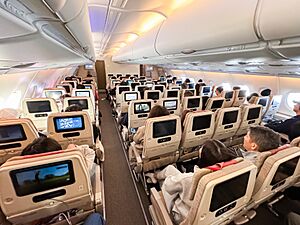
Asiana Airlines offers different types of seating and services. These include First Suite Class, First Class, Business Smartium Class, Business Class, and Travel (economy) Class. What you get depends on the type of plane and where it's flying.
First Suite Class is available on the Airbus A380-800 planes. These planes fly to cities like Los Angeles, New York City, Sydney, and Frankfurt. Passengers in these top classes get special items like pajamas and amenity kits. They can also order their meals before the flight. These seats have personal entertainment systems.
Most of Asiana's international flights offer two main classes: Business Smartium Class or Business Class, and Travel Class. Some shorter international flights and charter flights have only one class. All domestic flights also have one class. Many of Asiana's Travel class seats have screens for movies or videos.
Magazines on Board
Asiana offers two magazines for passengers. One is called Asiana, which is a travel magazine. The other is Asiana Entertainment.
Frequent Flyer Program
Asiana Club is the airline's program for frequent flyers. It used to be called Asiana Bonus Club. Members can earn miles when they fly with Asiana Airlines or other Star Alliance airlines. They can also earn miles with partner airlines like Qatar Airways. These miles can be used for free tickets, upgrades to a higher class, or other services.
Partnerships
Asiana Airlines works with several famous people and groups. These partnerships help promote the airline.
- Park Ji-Sung – a famous soccer player
- K. J. Choi – a professional golfer
- Yang Yong-eun – a professional golfer
- Chan-Ho Park – a former baseball pitcher
- YG Entertainment – a music and talent company
- JYP Entertainment – a music and talent company
- KBS Symphony Orchestra
- Korea National Ballet
Safety and Incidents
Airlines work hard to be safe, but sometimes incidents happen. Here are some past events involving Asiana Airlines:
- On July 26, 1993, an Asiana Airlines Boeing 737-500 had an incident near Mokpo Airport in bad weather.
- On November 11, 1998, an Asiana Airlines Boeing 747-400 had a small collision with another plane at Ted Stevens Anchorage International Airport while turning. No one was hurt.
- On June 9, 2006, Asiana Airlines Flight 8942, an Airbus A321-131, flew through hail near Gimpo Airport. The front of the plane was damaged, but no one was injured.
- On July 28, 2011, Asiana Airlines Cargo Flight 991, a Boeing 747-400F cargo plane, had a fire in its cargo area and crashed into the East China Sea.
- On July 6, 2013, Asiana Airlines Flight 214, a Boeing 777-200ER, had an incident while landing at San Francisco International Airport.
- On April 14, 2015, Asiana Airlines Flight 162, an Airbus A320, had a hard landing at Hiroshima Airport in Japan. More than 20 people were injured.
- On April 9, 2019, Asiana Airlines Flight 8703, an Airbus A320-232, had a nose gear issue upon landing at Gwangju Airport.
- On May 26, 2023, a passenger opened an emergency exit on Asiana Airlines Flight 8124, an Airbus A321-200, as it was approaching Daegu International Airport. The plane landed safely, but some people were taken to the hospital.
See also
 In Spanish: Asiana Airlines para niños
In Spanish: Asiana Airlines para niños
- Transport in South Korea
- List of companies of South Korea
- List of airlines of South Korea
- List of airports in South Korea
- List of Asian airline holding companies


